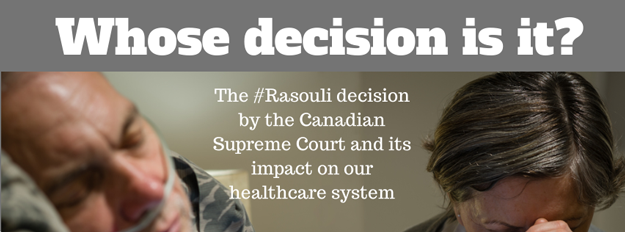When Enough is Enough: Musings on the End of Work and Life
When I tell people that what I do professionally is “look after older people,” I often hear responses such as: “Oh, that must be so depressing;” or sometimes, “Isn’t that wonderful, you must be a special human being;” and on occasion, “there are so few of you—what will be in the future with so many old people using up health care resources?” When I add that I am also involved in palliative care, you can imagine the response, but usually permutations on the “dealing with death every day must be the most depressing thing a doctor can do, how do you do it?” Just think, combining looking after the elderly person in a palliative care setting might be interpreted by those who have never had to experience such a combination as the ultimate in depressing; something that only a “saint” or “medical masochist” would choose as a profession.
First, to settle the issue, my colleagues and I involved in the same domains of medicine are neither saints nor, for sure, masochists. In fact, I could say that for all the health care providers, such as nurses, occupational and physical therapists, social workers, dieticians, and pharmacists, undertake their professional responsibilities with dedication, commitment, and the utmost in humanity. They usually combine these attributes with an enormous respect and interest in the narratives, the family interactions, and ties that each of their patients bring with them, irrespective of their illness. Having spent a career undertaking many aspects of medical practice from Internal Medicine and all of its subspecialties, including intensive care, I have no hesitation saying that my colleagues and I probably share much good humor, laughs, life’s pleasures, and experiences, as well as tragedies with our patients and families. They all share a wealth of human experience with all its fascinations, accomplishments and disappointments.
Within this context it is worth considering the wide range of beliefs and values that older people and their families carry within them as they contemplate the latter period of their life. This may be combined with significant personal physical pain and psychological anguish. At times there is the clear acknowledgement that they are “getting close to the end” and do not want to prolong a life that they have long ago accepted as finite and do not wish to risk suffering during their very twilight days, weeks or months.
It was with this in mind that I was especially impressed by a few newsworthy items that seemed to address the universal human struggle about life and the trajectory towards death from different perspectives. First there was a very moving piece in the February 2, 2013, New York Times written by Louise Aronson, an associate professor of medicine and geriatric specialist at the University of California, entitled, “Weighing the End of Life,” which in fact focused on her aging dog and all the trials and tribulations she faced deciding on when “enough was enough.” She eventually decided to have this wonderful, loving, and loved pet put down. In the article she mused, “Since then (after the dog was euthanized), I have often wondered whether we waited too long. We counted the time he spent sleeping as contentment ... I know that in elderly humans, sleep is more often a sign of chronic exhaustion, depression, and avoidance of pain. In dealing with the guilt brought on by our mixed feelings — we love him; he’s ruining our lives — I realize we may have overcompensated to his detriment. With dying humans, similar situations arise every day: hospital stays that fix the acute problem and worsen the chronic ones; emergency department visits that yield diagnoses, but require weeks of recovery from the waiting and testing; surgeries that are themselves minor, but provoke major confusion, complications, and hated nursing home stays.” She finished her essay with the story of a very elderly man with many illnesses who refused hospitalizations recommended by her. As she says in her final sentence, “He wanted to live — just not in the hospital, with poisons in his blood. He was sick and tired of feeling sick and tired. Like so many, his was a reasoned and reasonable stance.”

Reading her essay reminded me of one of the latter poems of Dylan Thomas (1914-1953) published in 1951: “Do not go gentle into that good night, Old age should burn and rave at close of day; Rage, rage against the dying of the light. Though wise men at their end know dark is right; Because their words had forked no lightning they Do not go gentle into that good night”. In the poem, the message is about fighting against the end of life while acknowledging the difficulty entailed and the struggles associated with the coming of life’s termination.
Of interest was at the time of The New York Times article about the dying of a dog, Pope Benedict XV1 shocked the world by his decision to step down as Pope, the first time in 600 years that such an event has occurred. The move raised a wide range of questions and speculation about the reasons and whether it would have been better to stay until his death, “fighting against his age-related (he is eighty-five years old) physical and emotional decline. As reported in a Time Magazine article on his decision, he wrote in his letter of resignation, 'After having repeatedly examined my conscience before God, I have come to the certainty that my strengths, due to an advanced age, are no longer suited to an adequate exercise of the Petrine (Papal) ministry ... this ministry, due to its essential spiritual nature, must be carried out not only with words and deeds, but no less with prayer and suffering. However, in today’s world ... both strength of mind and body are necessary, strength which in the last few months has deteriorated in me to the extent that I have had to recognize my incapacity to adequately fulfill the ministry entrusted to me.'”
There is a contrast to the final years and months of the previous Pope Jean Paul 11, who prior to his death, according to a report in the American Catholic website, spoke with increasing frequency about his age, his failing health, and death. The Vatican never formally acknowledged that the Pope suffered from Parkinson’s disease until after his death, although the tremor in the Pope's hand became unmistakable in the early 1990s, and media references to Parkinson's disease circulated for a decade before the Pope's death. In 1996, papal spokesman Joaquin Navarro-Valls was given a formal reprimand by the Secretariat of State for making a public comment about the possibility that the Pope was suffering from an "extrapyramidal syndrome"— an indirect reference to Parkinson's disease. Unlike Benedict XVI, he was determined to stay at the helm of the church, but also said he was prepared to be called to the next life. "It is wonderful to be able to give oneself to the very end for the sake of the kingdom of God. At the same time, I find great peace in thinking of the time when the Lord will call me: from life to life," he said in a 1999 letter written to the world's elderly. One could argue if staying at the Church’s helm in a state of failing health does more of a service to the Church than to resign as Benedict has done.
The last relevant media story reflecting when “enough is enough” is the suicide note, reported in a Globe and Mail newspaper letter to the editor published on Feb 8, 2013. In it, Ruth Goodman of Vancouver, writes, “I am a 91-year-old woman who has decided to end my life in the very near future. I do not have a terminal illness; I am simply old, tired and becoming dependent, after a wonderful life of independence. People are allowed to choose the right time to terminate their animals’ lives and to be with them and provide assistance and comfort, right to the end. Surely, the least we can do is allow people the same right to choose how and when to end their lives … I am writing this letter to advocate for a change in the law so that all will be able to make this choice.”
Of interest in terms of the wording chosen to describe the Pope’s decision to resign, Cardinal Timothy M. Dolan, the archbishop of New York, said, “By stepping down, the pontiff was saying, ‘my death is here; I feel weak, I feel fragile, I am frail.’” These words seem to echo those of Ruth Goodman. One can almost project that for a Pope to resign, something that has not been done for centuries, that might be in many ways akin to voluntarily leaving this world or at least what in essence is his world.
There were many letters to the editor following the printing of Ruth’s letter, some missing the point and referring to the “value” of the elderly rather than the issue which was Ruth’s concern, the personal decision to determine in one’s own world and life and when for each individual, “enough is enough”.
Acknowledgement
This article was first published on www.bestthinking.com
References
1. Aronson L. Weighing the End of Life. New York Times, February 2, 2013. http://www.nytimes.com/2013/02/03/opinion/sunday/weighing-the-end-of-life.html?_r=0&pagewanted=print
2. Thomas D. Do not go gentle into that good night. Poetry.org. http://www.poets.org/viewmedia.php/prmMID/15377
3. Text of Pope’s Resignation Announcement. Time Magazine: Associated Press Feb. 11, 2013. http://world.time.com/2013/02/11/text-of-popes-resignation-announcement/
4. Goodman R. Her last choice. Globe and Mail, Feb 8, 2013. http://www.theglobeandmail.com/commentary/letters/feb-8-lawyer-love-and-other-letters-to-the-editor/article8367639/

